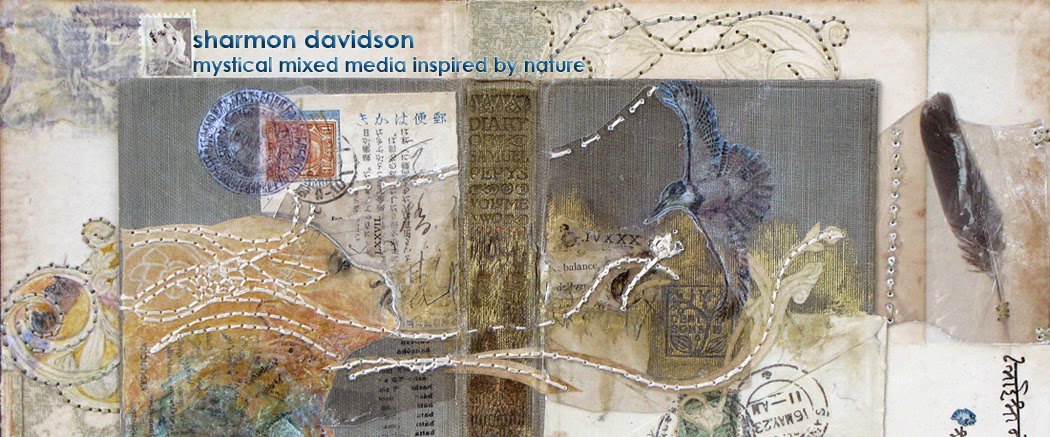If you've ever felt stuck, like you're basically just doing the same painting/collage/sculpture (or whatever) over and over again, you're not alone. Once you find a technique, style, or process that's successful for you, it's easy to get stuck in a rut. It works, and you feel comfortable with it. If it ain't broke, don't fix it, right?
This is usually when a little nagging voice inside my head starts picking and poking at me, going, "too safe, too much the same, too easy." I want to be brave, and innovative, to do something new. I want to push myself beyond where I am now, into more unfamiliar territory, to improve and grow as an artist. This is generally way more easily said than done. Humans are creatures of habit, and old habits die hard. So how do we force ourselves to press forward, to abandon what's safe and familiar, to get, for lack of a better word, better?
1) Brainstorm at least ten ideas, then throw the first ten away.
This really makes you think outside the box. It sounds crazy, but by the time you get to #11, you are so far outside the box, you don't even know where it is any more. Scary. You are starting to come up with ideas that also sound crazy, and are unlike anything you've thought of before. Try one of the ideas that feels like you are really reaching, and see what happens; you may just amaze yourself.
This assemblage/sculpture/book, called Indigenous, consisted of a wooden box with rocks as 'pages' onto which plant parts and seeds were glued. The rocks had holes in them, and were hung on sticks which went through the holes and into the back of the box. Ironically, they were literally in a box (haha!), but rocks as pages with plants parts glued on was pretty far removed from anything I'd done up until that time.
2) Make 50 pieces in one weekend.
This is completely insane, right? At least, that's what I thought when I was given this assignment in graduate school. Not possible. Can't be done. Of course, everyone in the class was freaking out. My logic was, since I highly doubted that I could draw or paint 50 pieces from scratch, to take a shortcut and use what I already had. I pulled out a bunch of old monotypes and started tearing and cutting them apart, then got out the glue and started making collages seven by seven inches square as fast as I could. I did manage to make 50, and some of them were pretty bad. But, much to my surprise, some were really beautiful. This exercise became the beginning of my still-ongoing Transformations series, and my first real foray into collage.
Transformation 12
Transformation 10
3) Switch mediums.
Self-explanatory, right? If you normally work in oils, switch to pastels; if you usually do black and white ink drawings, try colored pencils. If you're a collage artist, try linocuts or monotypes. This is guaranteed to force you to change your process, even if you stick with your usual subject matter.
Air Mandala
Olivine Angel, monotype with mixed media
4) Switch sizes.
This can make a huge difference in how you work; the greater the change in size, the more you will have to adapt. I went from making pieces that averaged about 15 by 22 inches (half the size of a sheet of Rives BFK) to doing a series of 3.5 x 3.5 inch abstract pieces I called "Seed Mandalas". This series also represents a change in medium, as I was using acrylic inks for the first time.
Seed Mandala 15
Seed Mandala 1
Seed Mandala 4
5) Limit materials.
If you limit your materials in some way, you have to expand your thinking. This is easy to do if you're a mixed media artist. For instance, you could limit yourself to using only magazine cut-outs, or only decorative papers, or only vintage ephemera. If you're a painter, limit your color palette to black and white, or to shades of the same color, or choose 3 colors and use only those.
The Pink Dress
Serendipity
When I began doing my weekly quick collage series, it was mainly a no-pressure way to use up scraps that were laying around after I had finished a large piece. I decided that I would do one each week, utilizing only the materials that were scattered over my drafting table and floor. This forced me to combine things in a way I probably wouldn't have if I'd allowed myself access to all my materials.
6) The George Costanza method.
This is probably my favorite one, only because it cracks me up. If you are a Seinfeld fan, you may recall the episode where George's life is basically in the the toilet - he has no job, no money, and lives with his parents. Nothing he tries seems to turn out right. So he decides that since whatever he normally does is wrong, he will do just the opposite of what he thinks he should do. I'm not sure exactly how this applies to art-making; you'll have to do a little creative thinking here. Perhaps if you would normally start by carefully putting everything in place before gluing it down, so instead just glue down the first thing you see and go from there?
That's what I did with this piece, and it's not bad, I think, though certainly different from the pieces that are more carefully thought out. I did learn from it, though. Only you can decide what to do the "opposite" of, and what that consists of for you. Or, just laugh at the video and do what you want!
Pointless

















